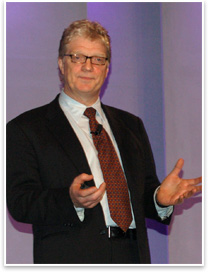
Summary: Can architects learn creativity? Sir Ken Robinson, expert on creativity in education and business, says yes. Robinson led a U.K. initiative called “The Arts in Schools Project” from 1985–’89, and in 1998 was appointed by the British government to chair England’s National Advisory Committee on Creative and Cultural Education. At Grassroots 2007, Robinson told AIA members that he believes creativity is applied imagination, which in turn can be applied to innovative and intelligent architecture. Robinson, who began his presentation with a series of comedic flourishes, got serious when talking about creativity, intelligence, and innovation—and how it all ties together for architects. “Creativity is applied imagination—putting it to work,” stressed Robinson. “Imagination is the most important feature in architecture, and we take it for granted.” Imagination is the most important feature in architecture, and we take Robinson pointed out that imagination is the capacity to picture, visualize, and conceive visually and verbally. “To put together combinations, this is the imagination of form—to hypothesize and speculate and put together a model from combinations. Creativity is the capacity to bring to mind those things that are not present and ask, ‘What if?’ Hypothesizing and creativity are the same process.” With imagination and creativity comes innovation, Robinson added. “Innovation is putting that creativity into practice based on something that you are interested in.” But always temper your creative judgment, he recommends, with intelligence. “The three keys of intelligence to use are objective truth, rational process, and empirical validation.” Misconceptions about creativity I believe you can cultivate creativity Imagination, creativity needed for a cultural revolution Robinson had three propositions—based on imagination, creativity, and innovation—for AIA architects about meeting the changing, growing built environment:
Rely on intelligence, concluded Robinson. “Intelligence is distinct—we all have a relevant sense that is diverse, dynamic, and distinct.” |
||
Copyright 2007 The American Institute of Architects. All rights reserved. Home Page |
||
home
news headlines
practice
business
design
recent related
› Successful Capitol Hill Visits Promote Sustainability
› AIA President Stewart Testifies on Energy Efficiency in Federal Buildings
› Component Awards, National Service Awards Conferred
You Need to Know What You Don't Know
Visit Sir Ken’s Web site.
Order Sir Ken’s book, Out of Our Minds: Learning to Be Creative (Capstone, 2006) from the AIA Bookstore online.

 Sir Ken Robinson Addresses the Intelligence of Being Creative at Grassroots 2007
Sir Ken Robinson Addresses the Intelligence of Being Creative at Grassroots 2007